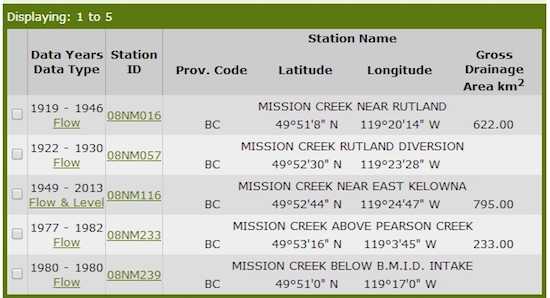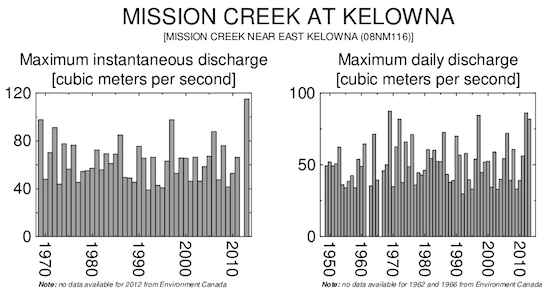By Sierra Rayne ——Bio and Archives--August 17, 2014
Global Warming-Energy-Environment | CFP Comments | Reader Friendly | Subscribe | Email Us
"Prior to 2007, Mission Creek rarely flowed at 100 cubic metres per second or higher; it's now a routine occurrence and has reached 130 cubic metres per second. With farming and hiking, soccer and baseball, housing and critical biodiversity all competing in the corridor, this is an important area and it would appear our annual melt exceeds the abilities of the corridor's dikes. 'I wouldn't say anybody has concluded that climate change is having a significant effect just yet, but we are seeing some pretty crazy flows compared to what we've seen in the past,' said [Todd] Cashin [from the City of Kelowna, environment and agriculture department division]."This seemed like an interesting claim, so I contacted the journalist who wrote the story to determine where exactly the data behind the claim that "prior to 2007, Mission Creek rarely flowed at 100 cubic metres per second or higher; it's now a routine occurrence and has reached 130 cubic metres per second" came from. I received no reply. According to the Environment Canada hydrometric database, there are only the following five hydrometric stations on Mission Creek.
 As is clearly evident, there is only one long-term station, which is also the only station in current operation: Mission Creek near East Kelowna (ID 08NM116). With a total drainage area of 859 square kilometers for Mission Creek before it discharges into Okanagan Lake, this hydrometric station includes 93 percent of the watershed, and is thus the best site for looking at how peak flows in the creek near the city have changed over time.
According to the Environment Canada database, the maximum daily discharge of Mission Creek has never exceeded 100 cubic metres per second, and certainly never reached 130 cubic metres per second. The same database indicates the first time Mission Creek's maximum instantaneous discharge ever exceeded 100 cubic metres per second was in 2013, specifically on June 20 of that year. And according to the flow data recorded every half-hour, the creek's flow only exceeded 100 cubic metres per second between 12:30 pm and 6:30 pm on June 20, 2013.
These facts appear to entirely contradict the claims in the Kelowna Capital News story quoted above, namely that flows above 100 cubic metres per second are "now a routine occurrence and [have] reached 130 cubic metres per second." In contrast, it looks like maximum instantaneous flows on Mission Creek have only exceeded 100 cubic metres per second for a six-hour period on a single day in mid-2013, and that the maximum flow on that day of about 115 cubic metres per second lasted for less than a half-hour.
There is also no evidence that either maximum instantaneous nor maximum daily flows on Mission Creek are increasing over time, as the figures below illustrate. In fact, the correlation is negative (towards lower peak flows over time) -- not positive -- for the maximum instantaneous flows, and neither the maximum instantaneous nor daily flow series show significant trends since their records began.
As is clearly evident, there is only one long-term station, which is also the only station in current operation: Mission Creek near East Kelowna (ID 08NM116). With a total drainage area of 859 square kilometers for Mission Creek before it discharges into Okanagan Lake, this hydrometric station includes 93 percent of the watershed, and is thus the best site for looking at how peak flows in the creek near the city have changed over time.
According to the Environment Canada database, the maximum daily discharge of Mission Creek has never exceeded 100 cubic metres per second, and certainly never reached 130 cubic metres per second. The same database indicates the first time Mission Creek's maximum instantaneous discharge ever exceeded 100 cubic metres per second was in 2013, specifically on June 20 of that year. And according to the flow data recorded every half-hour, the creek's flow only exceeded 100 cubic metres per second between 12:30 pm and 6:30 pm on June 20, 2013.
These facts appear to entirely contradict the claims in the Kelowna Capital News story quoted above, namely that flows above 100 cubic metres per second are "now a routine occurrence and [have] reached 130 cubic metres per second." In contrast, it looks like maximum instantaneous flows on Mission Creek have only exceeded 100 cubic metres per second for a six-hour period on a single day in mid-2013, and that the maximum flow on that day of about 115 cubic metres per second lasted for less than a half-hour.
There is also no evidence that either maximum instantaneous nor maximum daily flows on Mission Creek are increasing over time, as the figures below illustrate. In fact, the correlation is negative (towards lower peak flows over time) -- not positive -- for the maximum instantaneous flows, and neither the maximum instantaneous nor daily flow series show significant trends since their records began.
 So where did the claims in the media come from? Good question, as I cannot find any data to support them.
In the nearby community of Vernon -- just north of Kelowna, the local newspaper printed a recent editorial advocating for water conservation measures and stating that "with the advance of climate change, increased evaporation will reduce the amount of water available in part by reducing the amount of snowpack." Advancing climate change reducing water availability via wintertime evaporation of the snowpack? Average wintertime temperatures in the Vernon area exhibit no significant trend since at least 1950. That doesn't support the concerns raised in this editorial.
Neither does the absence of a significant trend in spring temperatures for the region over the past century, and a near-significant cooling trend over the last 30 years. There has been no significant trend in average summertime or autumn temperatures for Vernon since records began in 1900. Once again, these facts rebut the concerns raised by local media editorials. Are local residents aware of their unchanging climate? or are they just being inundated by alarmist propaganda not supported by real climate data?
By the way, there have been no temporal changes in regional annual water yields for the Okanagan Basin over the past century, despite large increases in population and agricultural activity over this time. This reality should mitigate excessive concerns over water scarcity in the region.
With a recent wildfire threatening West Kelowna, British Columbia Premier Christy Clark made the following public statement:
So where did the claims in the media come from? Good question, as I cannot find any data to support them.
In the nearby community of Vernon -- just north of Kelowna, the local newspaper printed a recent editorial advocating for water conservation measures and stating that "with the advance of climate change, increased evaporation will reduce the amount of water available in part by reducing the amount of snowpack." Advancing climate change reducing water availability via wintertime evaporation of the snowpack? Average wintertime temperatures in the Vernon area exhibit no significant trend since at least 1950. That doesn't support the concerns raised in this editorial.
Neither does the absence of a significant trend in spring temperatures for the region over the past century, and a near-significant cooling trend over the last 30 years. There has been no significant trend in average summertime or autumn temperatures for Vernon since records began in 1900. Once again, these facts rebut the concerns raised by local media editorials. Are local residents aware of their unchanging climate? or are they just being inundated by alarmist propaganda not supported by real climate data?
By the way, there have been no temporal changes in regional annual water yields for the Okanagan Basin over the past century, despite large increases in population and agricultural activity over this time. This reality should mitigate excessive concerns over water scarcity in the region.
With a recent wildfire threatening West Kelowna, British Columbia Premier Christy Clark made the following public statement:
"'I don't anticipate -- given the realities of climate change and the drying climate here in British Columbia -- that we're going to see a smaller fire threat for the future,' Clark said. 'We need to always think about what we can do to be more prepared next time.'"The "realities of climate change"? What exactly are those? Clark's statement sounds very unscientifically Obama-esque in its assertions. The drying climate in British Columbia? Here are some climate realities for Clark to consider. Since records began in 1899, the Kelowna area has seen a highly statistically significant increase -- not decrease -- in annual precipitation. The region is getting much wetter over time, not drier. There is also a significant trend towards more summertime precipitation at Kelowna since 1899. This increasing precipitation, both year-round and in the summertime, undercuts suggestions that the devastating 2003 wildfire at the city limits -- which destroyed a substantial number of homes -- was due to climate change. To further probe the premier's climate science theories, I looked at the trends in annual precipitation for all 100 stations in British Columbia from the long-term Environment Canada Adjusted and Homogenized Canadian Climate Data (AHCCD) database. Not a single one of the 100 climate stations in British Columbia has a significant declining trend in annual precipitation since records began. Sixty-six percent of the stations have a significant increasing trend, and ninety percent of the stations have either a significant increasing trend or a non-significant trend with a positive correlation. The verdict is clear: there is unequivocal evidence that British Columbia is getting wetter over time, not drier as the premier has claimed. In a recent Globe and Mail article on climate change and wildfires, mention was also made of research efforts near Cranbrook -- in the southeastern portion of the province:
"'In our Cranbrook [research] area we have fire records back to the 1300s,' [Lori Daniels, an associate professor at the University of British Columbia] said, referring to the data being gathered from tree rings. Now, driven by climate change and fuelled by a stockpile of debris, the forests of B.C. are headed for another period of frequent fires."
View Comments
Sierra Rayne holds a Ph.D. in Chemistry and writes regularly on environment, energy, and national security topics. He can be found on Twitter at @srayne_ca